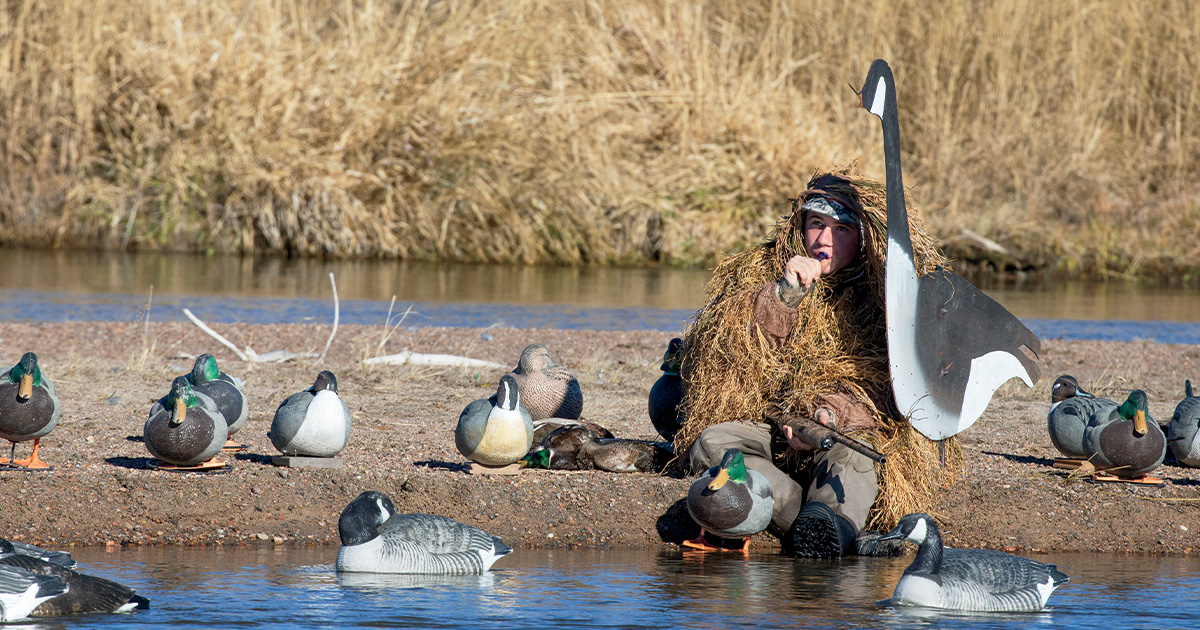Waterfowler's World: Beyond the Blind
Concealment tips for the mobile hunter
Concealment tips for the mobile hunter

By Bill Buckley

With a little ingenuity, hunters can conceal themselves almost anywhere. Wearing a ghillie suit and hiding in the shade beside a large silhouette decoy can work in a pinch.
Unlike those waterfowlers who are accustomed to hunting from permanent blinds, mobile hunters usually try to hunt wherever they have located concentrations of birds. Often this means there is no blind available, so they look for the best spot to set up and determine what they need to do to blend in. Here are some strategies for staying hidden in these situations.
Wherever you hunt, be mindful of shadows. In flooded timber, you’ll disappear leaning against the shady side of a tree. Along shorelines with brush or trees, setting up on the north or west side will keep you hidden most of the morning. In areas with lots of cover, like cattail marshes, set up where you’ll be in the shade after sunrise. In flat stubble fields where there’s no apparent structure, lying in ruts made by tractor or pivot tires can lower your profile just enough to help keep you shaded during the first hour after sunrise.
According to Montana hunter Bob Farrell, hunters in agricultural fields can take advantage of rolling topography. Whenever possible, he recommends hiding along southern field edges where nearby hills will cast long shadows well into the morning.
Logs and fallen trees on gravel bars are a boon for river hunters. If there aren’t any shadow-casting objects or features, you can add them. Tumbleweeds or clumps of tall grass or stubble can be placed along the sunny side of layout blinds. Even goose decoys can provide some shade.
Movement draws attention. No matter how well you may think you’re hidden, don’t move when birds are closing in and facing your direction. If you have to shift position or move your gun to get ready to shoot, wait until birds are swinging away. The same goes for calling. According to Bill Cooksey, a veteran waterfowl hunter from Tennessee, calling too much or at the wrong time will only draw attention to you. “Call ducks at the corners, when they’re swinging and facing away from you,” he says. “If you picture a spot you want them to finish, rather than trying to get them to come to you generally, you’ll be much more effective.”
If cover is sparse or you’re working educated birds, set up where decoying birds are flying by you, not at you. An effective strategy for field-hunting geese away from field edges is to set up for crossing shots, with the hunters hiding in a patch of natural cover or a small cluster of decoys off to the side of the main spread, perpendicular to the wind. The geese will be focused on the main concentration of decoys and not on you.
Even with all the hiding cover of a cattail marsh, New York hunter and DU Director of Conservation Programs Sarah Fleming and her husband, Dr. Michael Schummer, often set up so ducks will approach from behind. “We hunt well away from shore,” she says, “so ducks have plenty of room to maneuver, and with all the cattails to our backs and the ducks focused on our decoys, they have no clue we’re there.”
If your face is exposed and shining, you’re going to flare birds. A face mask is an easy fix, but make sure it matches your surroundings. Savvy hunters own a variety of masks to blend in with different environments. For ultimate versatility, a ghillie suit’s textured effect can help you disappear almost anywhere. Shouldering a shotgun can be problematic, however, and the much sparser and lighter 3D leafy-cut camo is more practical for waterfowlers. Not only do these garments look more like natural vegetation, their uneven, textured surface is completely non-reflective.
Staying lower than the surrounding cover will help keep you from standing out. Where field stubble or shoreline vegetation is sparse, conventional layout blinds are usually too high to blend in and not cast bird-spooking geometric shadows. A very effective alternative is a low backrest and pad coupled with a ghillie blanket. Also, keep your retriever hidden in a low-profile dog blind or have him lie down and cover him up.
Ducks Unlimited uses cookies to enhance your browsing experience, optimize site functionality, analyze traffic, and deliver personalized advertising through third parties. By continuing to use this site, you agree to our use of cookies. View Privacy Policy